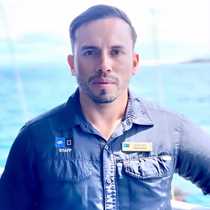Santiago Island: Caleta Bucanero and Puerto Egas
This time, the National Geographic Endeavour navigated toward our adopted island. Santiago, also known as James, was the territory for many interesting projects that the National Park has done over time to eradicate the introduced species of animals on the island. A place well-visited back in time by pirates and buccaneers, even Charles Darwin spent nine days on this enchanted island. It is a remote place, holding old stories from sailors and first settlers. We started early in the morning with a wet landing on Espumilla Beach, a beautiful area with giant incense trees, a territory patrolled by the endemic Galápagos hawk…
Exploring the surroundings of this island, we soon arrived to Buccaneer’s Cove, where we had the chance to snorkel and kayak along the titan cliffs that enclose this area. Some semi-tropical species of fish were spotted as well as much interesting marine life living among the vertical walls of the bay. The water was refreshing and we certainly had a very good time snorkeling out here.
After lunch we moved to a different side of Santiago; we landed on Egas Port, a place where salt miners tried to establish, but nature and the rusty island would always win, avoiding human settlement. Interesting geological features are found on this place; many eroded tuff cones and cinder cones, with the very black rusty lava flows bathing the coastal area. Some of these lava flows have collapsed lava tubes reaching the ocean that have turned into a perfect habitat for the Galápagos fur sea lion.




